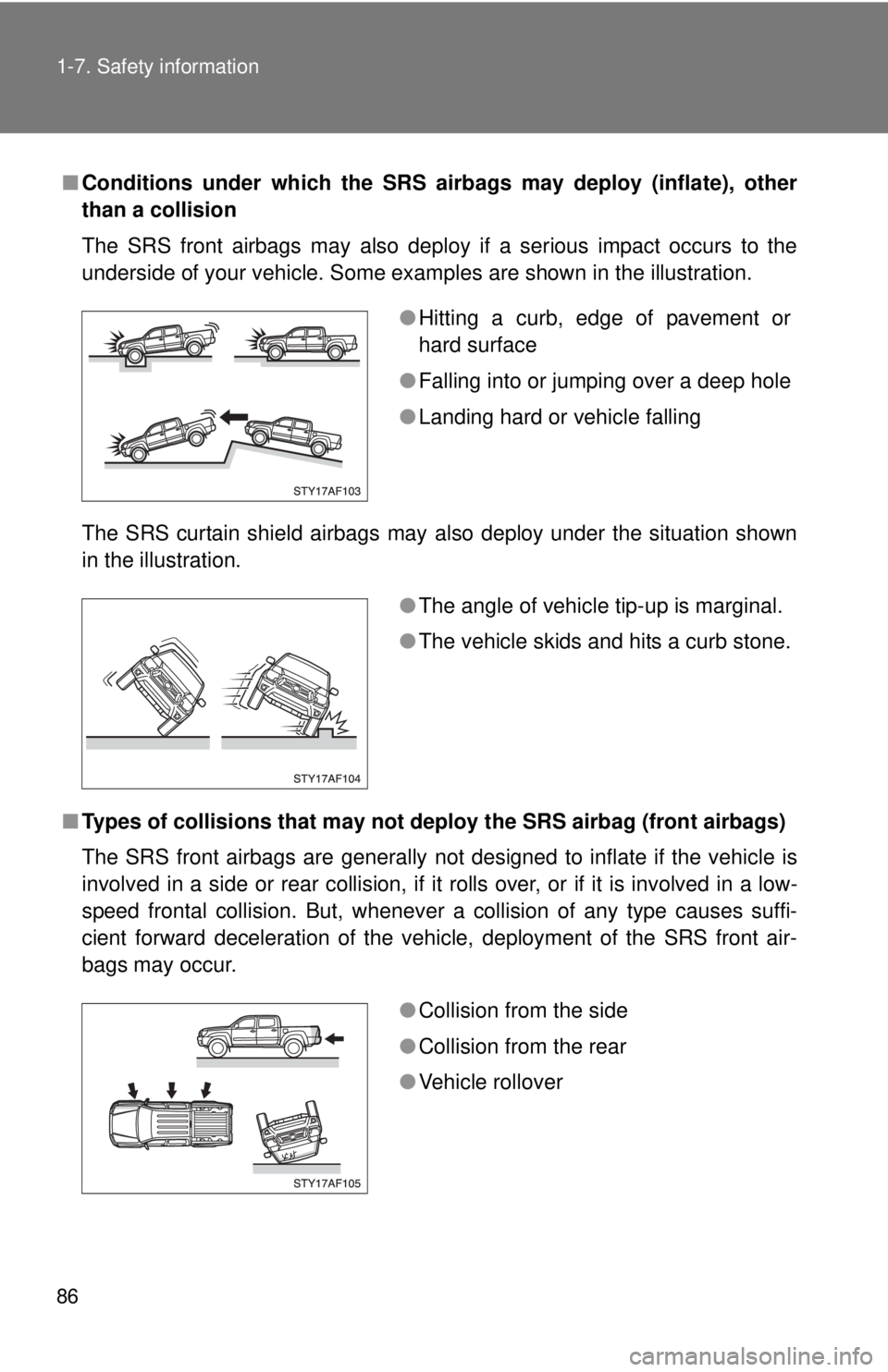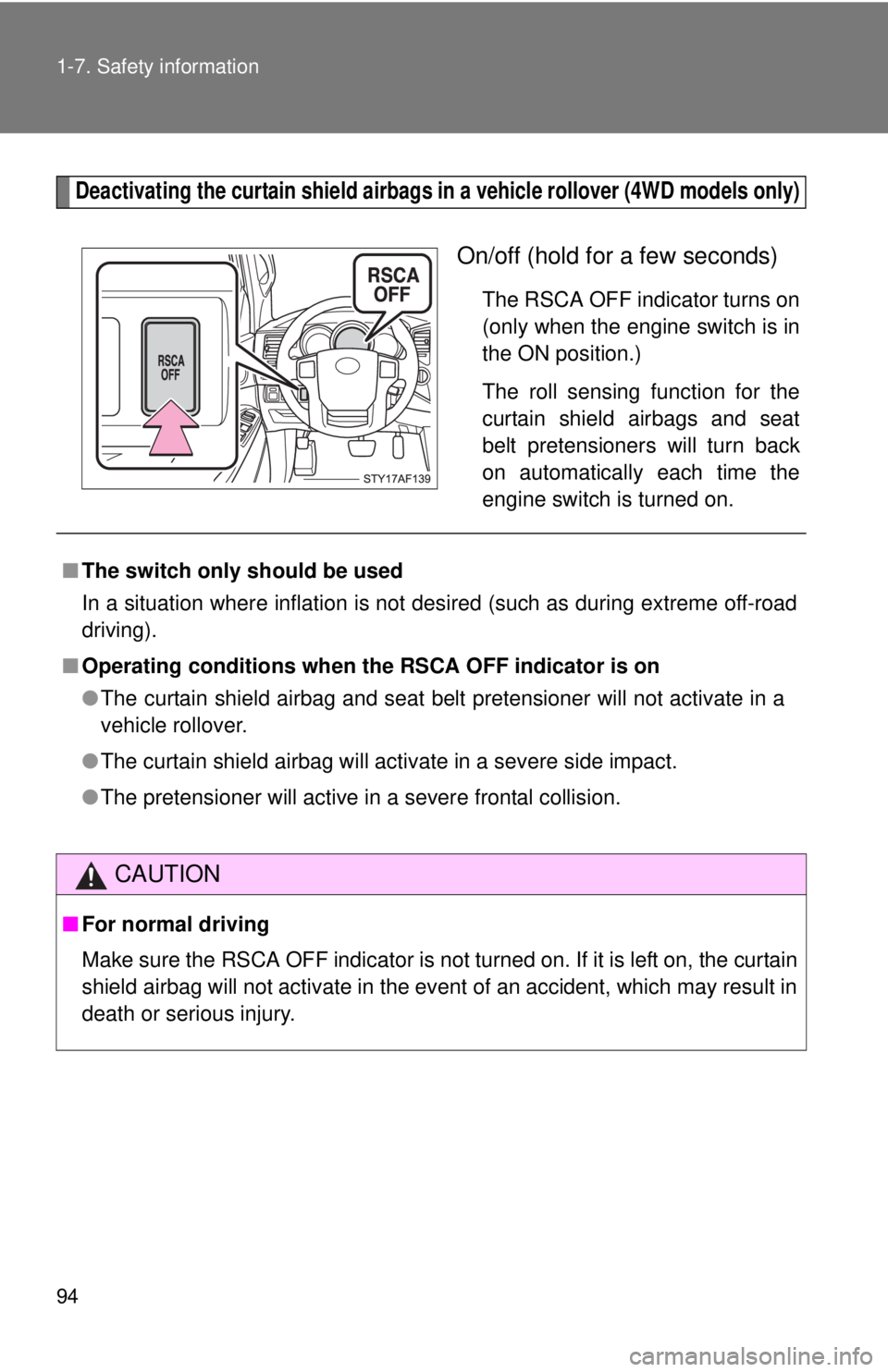2015 TOYOTA TACOMA air condition
[x] Cancel search: air conditionPage 1 of 590

TABLE OF CONTENTS
1
1Before drivingAdjusting and operating features such as door locks,
mirrors, and steering column.
2When drivingDriving, stopping and safe-driving information.
3Interior and
exterior featuresAir conditioning and multimedia systems, as well as
other interior features for a comfortable driving experi-
ence.
4Maintenance
and careCleaning and protecting your vehicle, performing do-it-
yourself maintenance, and maintenance information.
5When trouble
arisesWhat to do if the vehicle needs to be towed, gets a flat
tire, or is involved in an accident.
6Vehicle
specificationsDetailed vehicle information.
7For owners
Reporting safety defects for U.S. owners, seat belt and
SRS airbag instructions for Canadian owners and
camper information.
IndexAlphabetical listing of information contained in this
manual.
Page 3 of 590

1
2
3
4
5
6
7
3
2-3. Operating the lights and wipers
Headlight switch .................. 152
Fog light switch ................... 155
Windshield wipers and washer .............................. 156
2-4. Using other driving systems Cruise control ...................... 162
Rear view monitor system... 166
Four-wheel drive system ..... 177
Active traction control system .............................. 181
AUTO LSD system.............. 183
Rear differential lock system .............................. 185
Downhill Assist Control system .............................. 188
Clutch start cancel switch ... 190
Driving assist systems ........ 191
2-5. Driving information Off-road precautions (4WD models and PreRunner).... 197
Cargo and luggage ............. 202
Vehicle load limits ............... 207
Winter driving tips ............... 209
Trailer towing ...................... 213
Dinghy towing ..................... 233 3-1. Using the air conditioning
system and defogger
Air conditioning system ...... 236
3-2. Using the multimedia system Multimedia system types .... 243
Entune Audio ...................... 245
USB port/AUX port ............. 249
Setup menu ........................ 250
Basic audio operations ....... 256
Using the radio ................... 261
Playing an audio CD and MP3/WMA/AAC discs ...... 263
Listening to an iPod ............ 270
Listening to a USB memory device ................. 276
Using the AUX port............. 281
Connecting Bluetooth
®....... 282
Listening to Bluetooth®
audio ................................ 304
Using a Bluetooth
®
phone ............................... 305
Operating the sub woofer (on some Access Cab
models) ............................ 334
Detachable pole antenna ... 335
3Interior and exterior
features
Page 4 of 590

TABLE OF CONTENTSIndex
4
3-3. Using the interior lightsInterior lights list ................. 338
• Interior light ...................... 339
• Personal lights ................. 339
3-4. Using the storage features List of storage features....... 340
• Glove box ......................... 341
• Front console box ............ 341
• Cup holders ...................... 342
• Bottle holders ................... 344
• Auxiliary boxes ................. 345
• Overhead console ............ 348
3-5. Other interior features Sun visors .......................... 349
Vanity mirrors ..................... 350
Clock .................................. 351
Power outlets (12 VDC) ..... 352
Power outlet (120 VAC) ..... 353
Seat heaters ....................... 359
Seatback table ................... 361
Floor mat ............................ 362
Luggage compartment features ............................ 364
Garage door opener ........... 373
Compass (vehicles with auto anti-glare inside
rear view mirror) ............... 381 4-1. Maintenance and care
Cleaning and protecting the vehicle exterior ........... 388
Cleaning and protecting the vehicle interior ............ 391
4-2. Maintenance Maintenance requirements .................... 394
General maintenance ......... 396
Emission inspection and maintenance (I/M)
programs
............................. 399
4-3. Do-it-yourself maintenance Do-it-yourself service precautions ....................... 400
Hood ................................... 404
Engine compartment .......... 406
Tires.................................... 422
Tire inflation pressure ......... 431
Wheels................................ 436
Air conditioning filter ........... 439
Wireless remote control battery .............................. 442
Checking and replacing fuses ................................. 444
Light bulbs .......................... 454
4Maintenance and care
Page 17 of 590

17
Emergency flasher switch P. 466
Multimedia system2
Rear view monitor system
2
P. 243
P. 166
Air conditioning system P. 236
A-TRAC switch2 P. 181AUX port/USB port P. 249
Power outlets P. 352
Front-wheel drive
control switch
1 P. 177
Pictorial indexInstrument panel
Seat heater switches2 P. 359
1: 4WD models only
2: If equipped
Page 33 of 590

33
1-2. Opening, closing and locking the doors
1
Before driving
■
Wireless remote control depletion
The standard battery life is 1 to 2 years. (The battery becomes depleted
even if the key is not used.) If the wireless remote control function does not
operate, the battery may be depleted. Replace the battery when necessary.
(P. 442)
■ If the wireless remote control does not operate
Locking and unlocking the doors: Use the key. ( P. 35)
■ Security feature
If a door is not opened within approximately 30 seconds after the vehicle is
unlocked, the security feature automatically locks the vehicle again.
■ Conditions affecting operation
The wireless remote control function may not operate normally in the follow-
ing situations.
●Near a TV tower, radio station, electr ic power plant, airport or other facil-
ity that generates strong radio waves
● When carrying a portable radio, cell ular phone or other wireless commu-
nication device
● When multiple wireless keys are in the vicinity
● When the wireless key has come into contact with, or is covered by a
metallic object
● When a wireless key (that emits radio waves) is being used nearby
● When the wireless key has been left near an electrical appliance such as
a personal computer
■ When riding in an aircraft
When bringing a wireless remote control onto an aircraft, make sure you do
not press any buttons on the wireless remote control while inside the aircraft
cabin. If you are carrying a wireless remote control in your bag etc, ensure
that the buttons are not likely to be pressed accidentally. Pressing a button
may cause the wireless remote control to emit radio waves that could inter-
fere with the operation of the aircraft.
■ Customization that can be co nfigured at Toyota dealer
Settings (e.g. wireless remote control system) can be changed.
(Customizable features P. 551)
Page 85 of 590

85
1-7. Safety information
1
Before driving
■
Operating conditions (front airbags)
●The SRS front airbag will deploy in the event of an impact that exceeds
the set threshold level (the level of force corresponding to an approxi-
mately 12-18 mph [20-30 km/h] frontal collision with a fixed wall that does
not move or deform).
However, this threshold velocity will be considerably higher if the vehicle
strikes an object, such as a parked vehicle or sign pole, which can move or
deform on impact, or if the vehicle is involved in an underride collision (e.g.
a collision in which the front of the vehicle “underrides”, or goes under, the
bed of a truck, etc.).
● Depending on the type of collision, it is possible that only the seat belt
pretensioners will activate.
● The SRS front passenger airbag will not activate if there is no passenger
sitting in the front passenger seat. However, the front passenger airbag
may deploy if luggage is put in the seat, even if the seat is unoccupied.
( P. 9 5 )
■ Operating conditions (side airb ags and curtain shield airbags)
The SRS side airbags and SRS curtain shield airbags will deploy in the
event of an impact that exceeds the set threshold level (the level of force
corresponding to the impact force produced by an approximately 3300 lb.
[1500 kg] vehicle colliding with the vehicle cabin from a direction perpendicu-
lar to the vehicle orientation at an approximate speed of 12-18 mph [20-30
km/h]).
■ Operating conditions (c urtain shield airbags)
The SRS curtain shield airbags are designed to inflate when the passenger
compartment is subjected to a severe impact from the side or vehicle roll-
over.
Page 86 of 590

86 1-7. Safety information
■Conditions under which the SRS airbags may deploy (inflate), other
than a collision
The SRS front airbags may also deploy if a serious impact occurs to the
underside of your vehicle. Some examples are shown in the illustration.
The SRS curtain shield airbags may also deploy under the situation shown
in the illustration.
■ Types of collisions that may not depl oy the SRS airbag (front airbags)
The SRS front airbags are generally not designed to inflate if the vehicle is
involved in a side or rear collision, if it rolls over, or if it is involved in a low-
speed frontal collision. But, whenever a collision of any type causes suffi-
cient forward deceleration of the vehicle, deployment of the SRS front air-
bags may occur.
● Hitting a curb, edge of pavement or
hard surface
● Falling into or jumping over a deep hole
● Landing hard or vehicle falling
●The angle of vehicle tip-up is marginal.
● The vehicle skids and hits a curb stone.
●Collision from the side
● Collision from the rear
● Vehicle rollover
Page 94 of 590

94 1-7. Safety information
Deactivating the curtain shield airbags in a vehicle rollover (4WD models only)
On/off (hold for a few seconds)
The RSCA OFF indicator turns on
(only when the engine switch is in
the ON position.)
The roll sensing function for the
curtain shield airbags and seat
belt pretensioners will turn back
on automatically each time the
engine switch is turned on.
■The switch only should be used
In a situation where inflation is not desired (such as during extreme off-road
driving).
■ Operating conditions when th e RSCA OFF indicator is on
● The curtain shield airbag and seat belt pretensioner will not activate in a
vehicle rollover.
● The curtain shield airbag will activate in a severe side impact.
● The pretensioner will active in a severe frontal collision.
CAUTION
■For normal driving
Make sure the RSCA OFF indicator is not turned on. If it is left on, the curtain
shield airbag will not activate in the event of an accident, which may result in
death or serious injury.